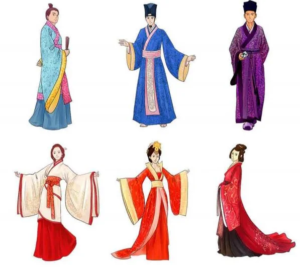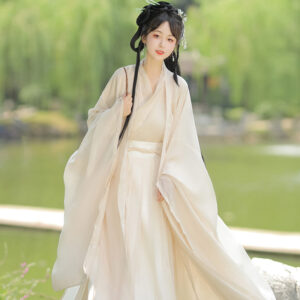

During the Han Dynasty (206 BC – 220 AD), Hanfu served as a significant indicator of social status, reflecting the rigid hierarchy of society through various elements such as materials, colors, designs, and motifs. The clothing worn by individuals was not merely a matter of fashion but a visual representation of their place within the social structure.
1. Materials Used
- Silk for the Elite: The upper classes, including royalty and high-ranking officials, predominantly wore silk garments. Silk was luxurious and expensive to produce, making it a clear marker of wealth and status. The quality and intricacy of the silk also indicated one’s rank.
- Hemp and Coarse Fabrics for Commoners: In contrast, commoners primarily wore garments made from more affordable materials like hemp and ramie. These fabrics were durable but lacked the elegance and refinement associated with silk, emphasizing the economic divide.
2. Color Significance
- Exclusive Colors: Certain colors were reserved for specific social classes. For instance, yellow was exclusively worn by the emperor, symbolizing supreme authority. Nobility often favored deep reds and purples, which were considered auspicious and indicative of high rank.
- Muted Tones for Lower Classes: Commoners typically wore muted or undyed fabrics. Bright colors were legally restricted for higher classes, reinforcing social stratification through color coding.
3. Distinctive Design Elements
- Intricate Designs for Nobility: The Hanfu of the upper class featured elaborate embroidery and intricate designs. Common motifs included dragons and phoenixes, which symbolized power and virtue. These designs were often accompanied by fine detailing that showcased the skill of artisans.
- Simplicity in Common Attire: In contrast, lower-class Hanfu was simpler in design, focusing on practicality rather than ornamentation. These garments had fewer layers and minimal decorative elements, reflecting the functional needs of everyday life.
4. Symbolic Motifs
- Motifs Indicating Rank: Specific motifs carried deep meanings tied to social class. For example:
- Dragons: Exclusively used by emperors to signify supreme power.
- Phoenixes: Often seen on noblewomen’s attire, representing grace and high virtue.
- Cultural Representation: The presence of certain symbols in embroidery or prints not only highlighted social status but also conveyed cultural values and beliefs prevalent during the Han Dynasty.
Table: Social Class Reflections in Hanfu
| Element | Upper Class (Nobility) | Lower Class (Commoners) |
|---|---|---|
| Materials | Predominantly silk; luxurious textures | Hemp or coarse fabrics; practical and durable |
| Color Significance | Bright colors (yellow for emperors, deep reds/purples) | Muted tones; often undyed or lightly dyed |
| Design Elements | Intricate embroidery; elaborate patterns | Simple designs; functional cuts |
| Symbolic Motifs | Dragons, phoenixes; symbols of power and virtue | Minimal motifs; focus on practicality |
Conclusion
The design and fabric choices in Han Dynasty Hanfu vividly illustrated the complex social hierarchy of ancient China. Each element—from materials to colors to motifs—served as a powerful indicator of one’s social standing, reinforcing societal norms and values while visually representing the stratified nature of Han society. This intricate relationship between attire and social class played a crucial role in maintaining order within the hierarchical structure of the time.
Share this post
Recent Posts


What were the key features of Hanfu during the Tang Dynasty?

How did Hanfu styles vary during different Chinese dynasties?

What accessories are typically worn with Hanfu?

How do you choose the right Hanfu for different seasons?

Newsletter
Popular Categories
Related Post
Sed aliquam, tortor et sodales malesuada, lorem leo luctus tellus, quis interdum eros nibh in nunc. Cras dignissim malesuada, lorem leo luctus

What are the winter hanfu called?

What were the key features of Hanfu during the Tang Dynasty?

How did Hanfu styles vary during different Chinese dynasties?


